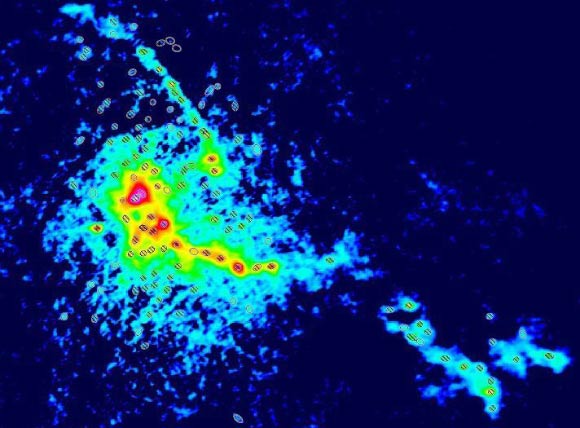An international team of astronomers has found that long-held assumptions about the relationship between the mass of star-forming clouds of dust and gas and the eventual mass of the star itself may not be as straightforward as scientists think. Their work is published in the journal Nature Astronomy.
The underlying reasons as to why a star eventually grows to a specific mass has puzzled astronomers for years.
It has been assumed that a star’s mass mostly depends on the original structure — known as a star-forming core — from which stars are born.
Within stellar nurseries all across the Universe massive molecular clouds begin to collapse and clump together under the influence of gravity to create star-forming cores. It is within these dense cores that material begins to collapse and heat up to a temperature hot enough to sustain nuclear fusion, from which the star begins to grow.
Observations from within our Milky Way Galaxy have shown that there is a link between the mass of the star-forming cores and the mass of the stars that they eventually spawn, and that there is a distribution pattern that is common throughout.
For instance, observations show relatively few stars that are more massive than the Sun, and that solar-mass stars are comparatively abundant. This distribution also shows that stars somewhat smaller than the Sun are even more common, but stars with a much smaller mass are less common.
A lingering question among astronomers has been whether or not they would see exactly the same distribution of star masses in other stellar clusters across the Universe, and whether this relationship between star-forming cores and stars themselves is similarly common.

The active star-formation region W43-MM1, as observed using ALMA: 1.3 mm dust continuum emission is presumed to trace the column density of gas, revealing high-density filaments and embedded cores; ellipses outline core boundaries (at half-maximum); core masses span the range 1 to 100 solar masses and can therefore be expected to spawn stars with masses from 0.4 to over 40 solar masses; all cores are shown; hashed ellipses indicate the most robust identifications. Image credit: Motte et al.
In the new study, the research team led by the Université Paris Diderot, the Université Grenoble Alpes and the Universidad de Chile used the Atacama Large Millimetre/Submillimetre Array (ALMA) to gain an unprecedented insight into W43-MM1 — part of Westerhout 43 (W43), a highly luminous galactic massive star-forming region located in the constellation Aquila, approximately 18,000 light-years away.
By using ALMA, the astronomers were able to observe star-forming cores with an extraordinary range, from those similar to the mass of our Sun to ones that were 100 times more massive.
To their surprise, the distribution of star-forming cores was completely different to what had previously been observed in nearby regions of the Milky Way.
In particular they observed an abundance of extremely big stars with huge masses, but less smaller stars that are more common within our Galaxy.
“The findings were a complete surprise and call into question the intricate relationship between the masses of star-forming cores and the masses of the stars themselves, which has long been assumed,” said team member Dr. Kenneth Marsh, of Cardiff University.
“As a consequence, the community may need to revisit its calculations regarding the complex processes that dictate how stars are born. The evolution of a core into a star involves many different physical interactions, and the results of studies such as this should help us better understand how it all happens.”
To support their current research, Dr. Marsh and colleagues now plan to study 15 star-forming regions similar to W43-MM1.
_____
F. Motte et al. The unexpectedly large proportion of high-mass star-forming cores in a Galactic mini-starburst. Nature Astronomy, published online April 30, 2018; doi: 10.1038/s41550-018-0452-x








